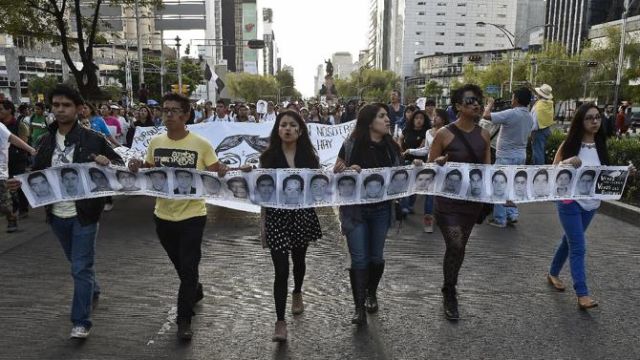
As 35 busloads of teacher-training students from Michoacan headed for Guerrero state to join increasingly militant protests for justice, students from major universities in Mexico City called a two-day strike on October 13. The protests were in response to the disappearance of dozens of students.
That day, Ayotzinapa students and teachers blocked highways and staged symbolic takeovers of banks and government buildings in Guerrero. Fires were set in state capitol buildings in Chilpancingo, in keeping with promises to escalate the protests if the 43 disappeared students were not returned alive.
Student groups from campuses of the National Autonomous University of Mexico, Metropolitan Autonomous University, Autonomous University of Mexico City, National Polytechnic Institute and the Universidad of Chapingo in the state of Mexico, gathered at the entrance to the main library in University City in the Federal District on October 13. They announced strikes over the next two days in support of the demands of Ayotzinapa students and their families.
Using the hashtag #ParoNAcionalYA, they invited students from other schools to join their protests. Student survivors of the police attack of September 26 in Iguala, Guerrero, took part in the activities.
A second strike was planned for October 22 and 23. A torchlight march from the Angel of Independence to the Zocalo was called for the night of October 22.
Students also demanded punishment for officials responsible for the disappearances and deaths of the students, including Iguala Mayor Jose Luis Abarca and Guerrero Governor Angel Aguirre. Six people were killed by police gunfire on the night of September 26-27, and 43 were taken away in police vehicles ― never to be seen again.
As discontent over the Iguala massacre continues to grow, experts and analysts rush to find reasons to explain the outrageous disappearance of 43 students from the Ayotzinapa rural Teacher Training College.
On the night of September 26, local police agents shot at several buses taken by the students in Iguala, Guerrero, who were trying to travel to demonstrations. Three of the students died, along with three civilians. Then the agents kidnapped 43 students and handed them over to the local criminal gang known as the United Warriors, according to authorities.
For Jorge Leon, a Mexican journalist who lived in Teloloapan, Guerrero, near Iguala, politics and power are behind it all, rather than the state's economic situation. Guerrero is one of the poorest areas in Mexico.
Leon believes the recent violent incidents are motivated by internal disputes to control Guerrero. The disputes are between the so-called Figueroistas, who support former governor and Institutional Revolutionary Party (PRI) member Ruben Figueroa Alcocer, and current governor Angel Aguirre, from the Democratic Revolutionary Party (PRD).
“What is behind the recent violent events in Guerrero is the … ‘Figueroista’ ambition to control the state,” Leon told teleSUR.
Figueroa governed Guerrero from 1993 to 1996. He stepped down in the middle of his term after the Aguas Blancas massacre, when 17 farmers were killed by Guerrero police.
After Figueroa stepped down as acting governor, the local congress named Aguirre, who in that time was a PRI member.
Leon added that the historic background of Guerrero is another major factor that may have prompted such violent acts.
“We must remember that [Ayotzinapa Teacher Training College] was part of the '70s leftist effervescence that ignited after the Tlatelolco Massacre,” said Leon.
On October 2, 1968, dozens of students were killed by the army during a demonstration in Tlatelolco square in Mexico City. They had been protesting against the government of former President Gustavo Diaz.
Leon said that rural schools, like the one in Ayotzinapa, have historically embraced leftist and revolutionary education. “Add to that the criminal groups, which have infiltrated local authorities so deeply that you cannot know who is really behind the power.”
[Compiled from TeleSUR English.]
Like the article? Subscribe to Green Left now! You can also like us on Facebook and follow us on Twitter.